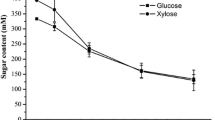Summary
Pachysolen tannophilus, a homothallic yeast, converts xylose to ethanol at a yield of 0.3 (g/g xylose). Concomitant with ethanol production, xylitol accumulates in the culture medium at similar yields (0.3 g/g xylose). The addition of the hydrogen-accepting compound, acetone, increases the amount of ethanol produced by this organism by 50–70%. The increase in ethanol is directly correlated with a decrease in xylitol secreted. The results indicate that conversion of acetone to 2-propanol by the cells provides the NAD+ used as a cofactor by xylitol dehydrogenase, the enzyme responsible for converting xylitol to xylulose.
Similar content being viewed by others
References
Alexander NJ (1985) Temperature sensitivity of the induction of xylose reductase in Pachysolen tannophilus. Biotechnol Bioeng 27:1739–1744
Barnett JA, Sims AP (1982) The requirement of oxygen for the active transport of sugars into yeasts. J Gen Microbiol 128:2303–2312
Bruinenberg PN, de Bot PHM, van Dijken JP, Scheffers WA (1983) The role of redox balances in the anaerobic fermentation of xylose by yeasts. Eur J Appl Microbiol Biotechnol 18:287–292
Bruinenberg PM, de Bot PHM, van Dijken JP, Scheffers WA (1984) NADH-linked aldose reductase: the key to anaerobic alcoholic fermentation of xylose by yeasts. Appl Microbiol Biotechnol 19:256–260
Bruinenberg PM, van Dijken JP, Scheffers WA (1983a) A theoretical analysis of NADPH production and consumption in yeasts. J Gen Microbiol 129:953–964
Bruinenberg PM, van Dijken JP, Scheffers WA (1983b) An enzymic analysis of NADPH production and consumption in Candida utilis. J Gen Microbiol 129:965–971
Bruinenberg PM, van Dijken JP, Kuenen GJ, Scheffers WA (1985) Oxidation of NADH and NADPH by mitochondria from the yeast Candida utilis. J Gen Microbiol 131:1043–1051
Debus D, Methner H, Schulze D, Dellweg H (1983) Fermentation of xylose with the yeast Pachysolen tannophilus. Eur J Appl Microbiol Biotechnol 17:287–291
Ditzelmuller G, Kubicek CP, Wohrer W, Rohr M (1984) Xylitol dehydrogenase from Pachysolen tannophilus. FEMS Microbiol Lett 25:195–198
Ditzelmuller G, Kubicek-Pranz EM, Rohr M, Kubicek CP (1985) NADPH-specific and NADH-specific xylose reduction is catalyzed by two separate enzymes in Pachysolen tannophilus. Appl Microbiol Biotechnol 22:297–299
du Preez JC, Prior BA, Monteiro AMT (1984) The effect of aeration on xylose fermentation by Candida shehatae and Pachysolen tannophilus. Appl Microbiol Biotechnol 19:261–266
du Preez JC, van der Walt JP (1983) Fermentation of d-xylose to ethanol by a strain of Candida shehatae. Biotechnol Lett 5:357–362
Kluyver AJ, Custers MThJ (1940) The suitability of disaccharides as respiration and assimilation substrates for yeasts which do not ferment these sugars. Ant v Leeuwenhoek 6:121–162
Mahler HR, Wilkie D (1978) Mitochondrial control of sugar utilization in Saccharomyces cerevisiae. Plasmid 1:125–133
Neirink LG, Maleszka R, Schneider H (1984) The requirement of oxygen for incorporation of carbon from d-xylose and d-glucose by Pachysolen tannophilus. Arch Biochem Biophys 228:13–21
Scheffers WA (1961) On the inhibition of alcoholic fermentation in Brettanomyces yeasts under anaerobic conditions. Exper 17:40–42
Scheffers WA (1966) Stimulation of fermentation in yeasts by acetoin and oxygen. Nature 210:533–534
Scheffers WA (1967) Effects of oxygen and acetoin on fermentation and growth in Brettanomyces and some other yeast genera. Atti del XIV Congresso della Societa Italiana di Microbiologia p 91–107
Scheffers WA, Wiken TO (1969) The Custers effect (negative Pasteur effect) as a diagnostic criterion for the genus Brettanomyces. Ant v Leeuwenhoek 35 (Suppl):A31–32
Schneider H, Wang PY, Chan YK, Maleszka R (1981) Conversion of d-xylose into ethanol by the yeast Pachysolen tannophilus. Biotechnol Lett 3:89–92
Sims AP, Barnett JA (1978) The requirement of oxygen for the utilization of maltose, cellobiose and d-galactose by certain anaerobically fermenting yeasts (Kluyver effect). J Gen Microbiol 106:277–288
Slininger PJ, Bothast RJ, van Cauwenberge JE, Kurtzman CP (1982) Conversion of d-xylose to ethanol by the yeast Pachysolen tannophilus. Biotechnol Bioeng 24:371–384
Toivola A, Yarrow D, van den Bosch E, van Dijken JP, Scheffers WA (1984) Alcoholic fermentation of d-xylose by yeasts. Appl Environ Microbiol 47:1221–1223
Watson NE, Prior BA, du Preez JC, Lategan PM (1984) Oxygen requirements for d-xylose fermentation to ethanol and polyols by Pachysolen tannophilus. Enz Microb Technol 6:447–450
Author information
Authors and Affiliations
Additional information
The mention of firm names or trade products does not imply that they are endorsed or recommended by the U. S. Department of Agriculture over other firms or similar products not mentioned.
Rights and permissions
About this article
Cite this article
Alexander, N.J. Acetone stimulation of ethanol production from d-xylose by Pachysolen tannophilus . Appl Microbiol Biotechnol 25, 203–207 (1986). https://doi.org/10.1007/BF00253649
Received:
Revised:
Issue Date:
DOI: https://doi.org/10.1007/BF00253649



